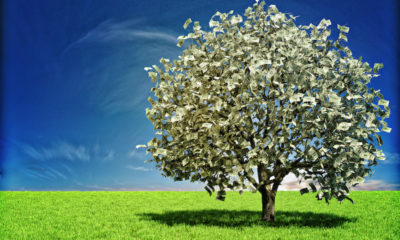Consumers
Credit Card Debt: America’s Looming Crisis
Almost a decade later, the 2008 financial crisis may seem like a distant memory to some. However, current trends in national credit card debt suggest that the next crash may just be on the horizon.
The Federal Reserve has reported that consumer credit card debt has reached a staggering $952 billion in the first quarter of this year. Comparing this to 2008, the year of the global financial crisis, the United States reached a record-breaking $1.02 trillion in outstanding credit balances.
Analysts are suggesting that if the total debt continues to rise at its current rate, the country is getting perilously close to another recession.
Credit Card Debt Has Been Steadily Increasing
The chart below outlays the revolving debt American's have since 2010

Over the last year alone, the total amount of consumer debt has risen by over $70 billion:
(Source: federalreserve.gov)
(Source: nerdwallet.com)
The reason behind this growth is contested amongst experts, but a prominent theory suggests that American consumers are simply becoming more willing to carry larger amounts of debt, increasingly so as the last financial crisis fades into memory.
Americans Aren’t Paying Off Their Debt
Over one third of American households remain in debt from a month-to-month basis, with the average level of household debt currently resting at over $15,000. In addition, the amount of interest being generated by these outstanding accounts is making it even harder for those in debt to work their way out of it.
American households that don’t carry a credit balance are more of a rarity than anything. Only 35% of credit card holders manage to fall into this category, using them to generate reward points rather than to borrow money they don’t have (time.com).
It is not uncommon for borrowers to ultimately wind up paying multiple times the original amount lent through interest (thedailycoin.org).
[ms_divider style=”normal” align=”left” width=”100%” margin_top=”30″ margin_bottom=”30″ border_size=”5″ border_color=”#f2f2f2″ icon=”” class=”” id=””][/ms_divider]
[ms_featurebox style=”4″ title_font_size=”18″ title_color=”#2b2b2b” icon_circle=”no” icon_size=”46″ title=”Recommended Link” icon=”” alignment=”left” icon_animation_type=”” icon_color=”” icon_background_color=”” icon_border_color=”” icon_border_width=”0″ flip_icon=”none” spinning_icon=”no” icon_image=”” icon_image_width=”0″ icon_image_height=”” link_url=”https://offers.thecapitalist.com/p/warrenbuffet/index” link_target=”_blank” link_text=”Click Here To Find Out What It Said…” link_color=”#4885bf” content_color=”” content_box_background_color=”” class=”” id=””]Warren Buffett Just Told His Heirs What He Wants them To Do With His Fortune When He Dies. [/ms_featurebox]
[ms_divider style=”normal” align=”left” width=”100%” margin_top=”30″ margin_bottom=”30″ border_size=”5″ border_color=”#f2f2f2″ icon=”” class=”” id=””][/ms_divider]
Americans Are Saving Less Than They Used To
The last financial crisis caused a large portion of Americans to be much more frugal in their spending habits. In 2008, personal savings was roughly 4% of total income for the average American, which skyrocketed to 11% by 2012 (fortune.com).
Now that the current rate of savings has gone back down to 5.4%, it suggests that Americans are becoming increasingly comfortable with looser spending habits, relying more heavily on borrowed money for large transactions.
Average Cost Of Living Is Increasing Faster Than Income Growth
The average income of the American household has increased significantly over the last decade, but it hasn’t necessarily increased average savings per family. The cost of medical care has inflated by over 50%, and groceries are 37% more expensive than they were in 2003 (nerdwallet.com).

Barack Obama’s plan for universal medical care promised to ease the average family’s medical expenses by as much as $2500. Since his election in 2008, however, premiums have increased by an average of $4800 per household (infowars.com).
(Source: mybudget360.com)
An Increasing Reliance On Subprime Borrowers
Over 10 million new credit cards were given to subprime consumers in the last year alone, representing a 25% increase from the end of 2014. This is the highest level it has ever been since 2007, right before the financial crisis.
On the other hand, banks that fall into this trend are making some efforts to keep history from repeating itself. One of the main strategies being employed requires the borrower to make an initial deposit that will represent the spending limit of that card (hotair.com). In the same way an auto loan is secured to the lender through the actual vehicle, having a required deposit may be an effective strategy to cover potential losses on credit loans.
Lucrative Returns For Credit Card Loans
There is actually a lot of variance in profit levels between banks when it comes to credit card loans. The industry average falls at around 12.4 cents per dollar on outstanding balances, but among the top-earning banks the average sits closer to 28.4 cents (creditcards.com).
Analysts suggest that consumer habits have a lot to do with some of the steep rates these banks are charging. Many borrowers can be reluctant to research what other kinds of deals are available to them and will pounce on the first seemingly reasonable opportunity they happen upon. In addition, credit lenders will often advertise rewards and discounts for their cards in order to distract buyers from high interest rates and hidden fees.
Read more: If you want to lower your student loan payment, click here
Banks Pushing Incentives For Credit Cards
Hundreds of reward-based credit card options are available for consumers, saturating the market with options. This variance in potential reward avenues give further incentive for the average consumer to own more than one credit card and add to the average household debt.
A recent study ranked the most valuable reward cards in terms of the monetary value of their rewards over a two-year period. The top 5 issuers were:
- Barclaycard – $1,529 (Arrival Plus)
- Capital One – $1,482 (Venture Rewards)
- Chase – $1,338 (Sapphire Preferred)
- US Bank – $1,151 (FlexPerks Travel Rewards)
- Citi – $1,141 (Double Cash Card)
Comparing 2016 to 2008: Is The Threat Real?
As the previous evidence suggests, consumer debt is currently at the same place it was before the recession hit in 2008. While credit card debt certainly was a factor in the market crash, much of it was due to subprime housing loans. In 2016, the bubble is now being inflated by loans to foreign governments.
The Japanese government’s debt is now twice that of its national GDP, takes a quarter of its entire tax revenue just to pay the interest, and yet the U.S. government is willing to pay Japan to borrow money at negative interest rates. This trend has accumulated over $7 trillion dollars of debt, adding to the $19 trillion owed by the government in total (sovereignman.com).
Compare this to the $9.5 trillion owed in 2008, and you can see why a lot of experts are getting worried.
Conclusion
It is rare that events in history play out exactly the same in every respect, particularly in the realm of finance. However, the amount of similarities between pre-recession America and now are certainly raising questions as to how far away the next financial crisis really is.













